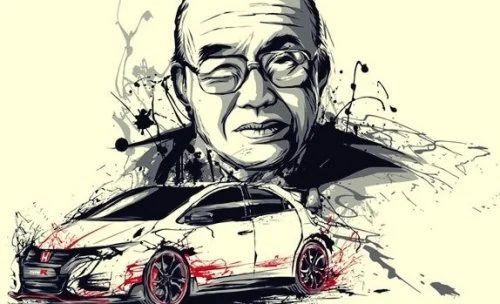In a small village near Hamamatsu, Japan, Soichiro Honda was born in 1906. The son of a blacksmith, Honda grew up around bicycles as his father ran a repair shop. During his early years, he assisted his father in the shop. At the time, his mother, Mika Honda, worked as a weaver. Honda was least bothered about traditional education. Students received their progress reports at school, but these needed a parental stamp of approval and a family mark indicating a parent had reviewed them.
Instead of being afraid of the challenge and failure, be afraid of avoiding the challenge and doing nothing.
Honda, ever resourceful, made a fake stamp to replicate his family seal using an old rubber bike pedal cover. However, his plan backfired when he tried to help classmates with similar forgeries, revealing his trickery.
Honda was unaware that the stamp was supposed to be mirror images. His family name was symmetrical when written vertically, so it did not cause a problem, but some other children’s family names were not.
During the Great Depression, in 1937, at the age of 31 years, he founded Tōkai Seiki to create piston rings for Toyota. He toiled and laboured night and day to create these, but to no avail. With little cash and bleak chances for survival, he had to pawn his wife’s ring to make ends meet. He failed and was told the rings didn’t meet Toyota’s specifications. During World War II, a US B-29 bomber attack destroyed Tōkai Seiki’s Yamashita plant in 1944, and the Iwata plant collapsed in the 1945 Mikawa earthquake.
What we learn through failure becomes a precious part of us, strengthening us in everything we do. So let the tough things make you tougher.
After the war, Honda sold the salvageable remains of the company to Toyota for ¥450,000 and used the proceeds to found the Honda Technical Research Institute in October 1946. In 1948, he started producing a completely motorized bicycle, the Type A, which was driven by the first mass-produced engine designed by Honda and was sold until 1951. The Type D in 1949 was a true motorcycle with a pressed-steel frame designed and produced by Honda and a 2-stroke, 98 cc (6.0 cu in) 3 hp (2.2 kW) engine. It became the very first model in the Dream series of motorcycles. The Society of Automotive Engineers of Japan (in Japanese) lists the Type A and the Type D models as two of their 240 Landmarks of Japanese Automotive Technology.
You can never go wrong with Honda.
After World War II, Soichiro Honda reconnected with an old friend who had worked with him while supplying aeroplane parts. Hired in 1949, this individual played a key role in managing the company’s finances and fueled its growth. By 1959, Honda’s motorcycles had reached the United States through the opening of their first dealership there. Under Honda’s leadership, the company transformed into a global powerhouse worth billions of dollars, becoming the world’s leading manufacturer of motorcycles. Their innovative engineering and strategic marketing allowed Honda motorcycles to surpass established brands like Triumph and Harley-Davidson in their countries.
Enjoying your work is essential. If your work becomes an expression of your own ideas, you will surely enjoy it.
Honda continued to lead the company as president until his retirement in 1973. He remained involved, taking on a director position and receiving the title of “supreme advisor” a decade later in 1983. A testament to his achievements, ‘People’ magazine recognized him as one of the “25 Most Intriguing People of the Year” in 1980, even comparing him to the legendary industrialist Henry Ford. After stepping down, Honda dedicated his time to endeavours supported by the Honda Foundation.
To read more motivational content, click here.
Voxcel aims to impart not only world-class IELTS coaching but also we look forward to develop the overall personality of our students.




